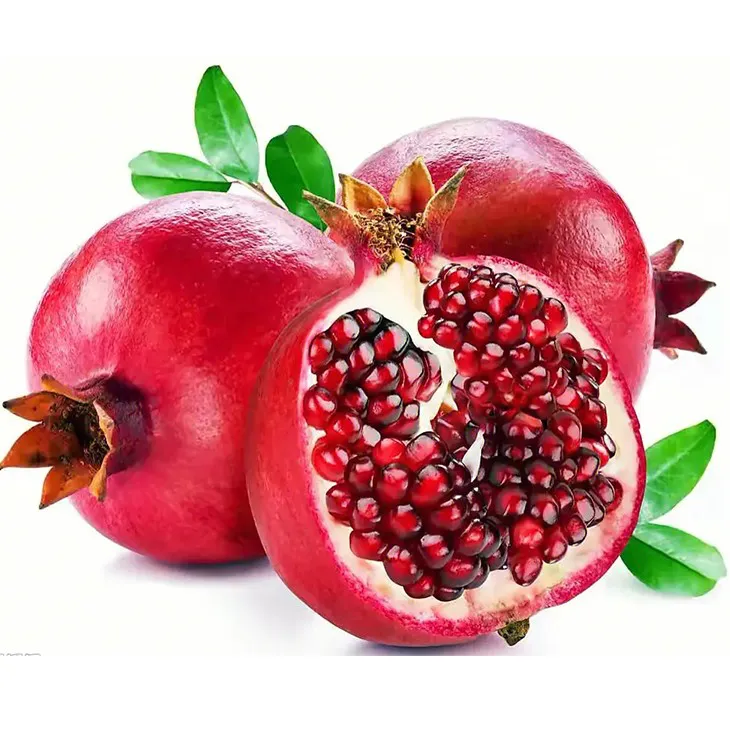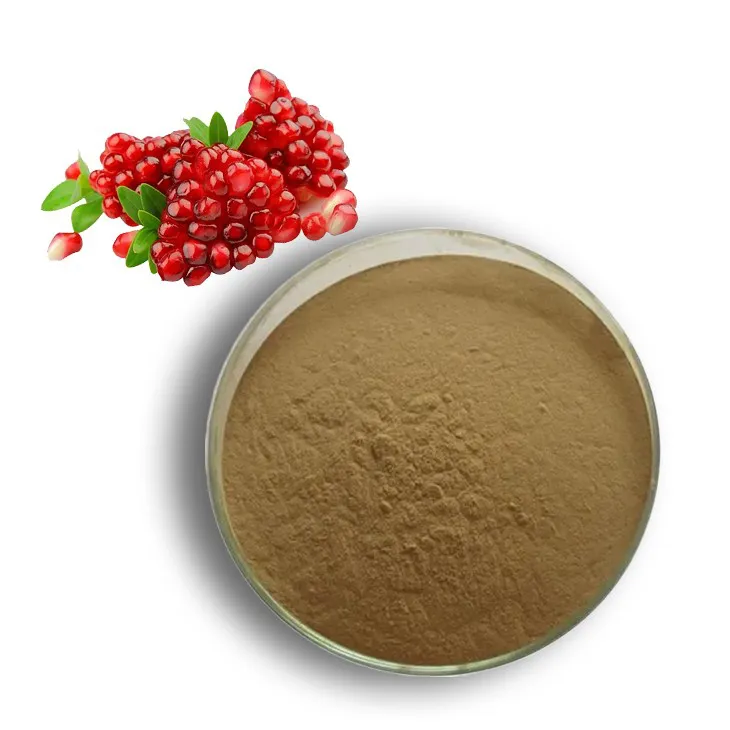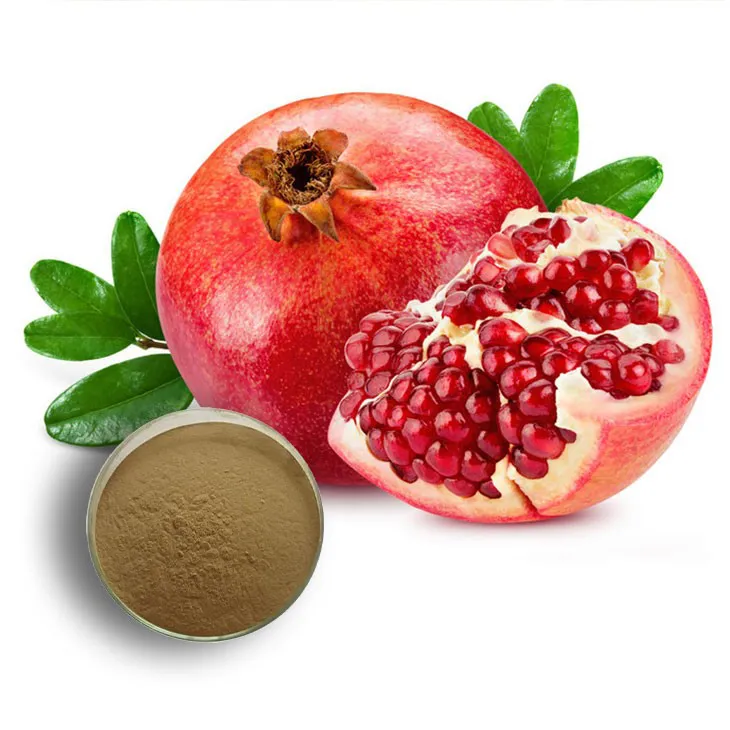- 0086-571-85302990
- sales@greenskybio.com
The extraction process of pomegranate extract.
2024-11-28

1. Introduction
Pomegranate, a fruit rich in various bioactive compounds, has gained significant attention in recent years due to its potential health benefits. Pomegranate Extract is widely used in the food, pharmaceutical, and cosmetic industries. The extraction process of Pomegranate Extract is crucial in obtaining high - quality products with desirable properties. This article will delve into the detailed extraction process, including raw material preparation, extraction techniques, and post - extraction refinement.

2. Raw material preparation
2.1 Selection of ripe pomegranates
The first step in the extraction process is the careful selection of ripe pomegranates. Ripe pomegranates are preferred as they contain higher levels of bioactive compounds. The maturity of pomegranates can be determined by several factors, such as their color, size, and firmness. For example, a ripe pomegranate usually has a deep red color and a slightly soft texture.2.2 Pre - processing
Once the ripe pomegranates are selected, they need to be pre - processed. This may involve different operations depending on the extraction method.- Peeling: In some extraction processes, the outer peel of the pomegranate may need to be removed. The peel contains certain compounds that may interfere with the extraction of the desired bioactive components from the arils or seeds. However, in other cases, the peel may also be a source of valuable compounds, so its removal may not be necessary.
- Deseeding: If the focus is on extracting compounds from the arils, the seeds may need to be removed. This can be a time - consuming process but is essential for obtaining a pure extract. There are mechanical and manual methods for deseeding. Mechanical methods can be more efficient for large - scale production, while manual methods may be more suitable for small - scale or research - based extractions.

3. Extraction techniques
3.1 Solvent extraction
Solvent extraction is one of the most common methods for obtaining Pomegranate Extract.- Choice of solvents:
- Ethanol - based solvents are widely used in pomegranate extraction. Ethanol is a relatively safe and effective solvent for extracting bioactive compounds such as polyphenols, flavonoids, and tannins from pomegranate tissues. It has the ability to dissolve a wide range of polar and semi - polar compounds.
- Other solvents like water can also be used, either alone or in combination with ethanol. Water - based extraction is more environmentally friendly, but it may extract different sets of compounds compared to ethanol - based extraction. For example, water may be more effective in extracting water - soluble vitamins and certain polysaccharides.
- Extraction process:
- The pomegranate material (either arils, seeds, or whole fruit in some cases) is mixed with the solvent in a suitable container. The ratio of solvent to sample is an important factor. A higher solvent - to - sample ratio may result in more complete extraction, but it also increases the cost and the volume of the extract that needs to be further processed.
- Temperature also plays a crucial role during extraction. Higher temperatures can generally increase the rate of extraction as it enhances the solubility of the bioactive compounds in the solvent. However, excessive heat may also cause the degradation of some heat - sensitive compounds. For example, some polyphenols may be oxidized at high temperatures, losing their antioxidant properties.
- Extraction time is another critical parameter. Longer extraction times can lead to a higher yield of the extract, but it may also introduce more impurities. Typically, extraction times can range from a few hours to several days, depending on the nature of the material and the desired compounds.
3.2 Supercritical fluid extraction
Supercritical fluid extraction (SFE) is an emerging technique for pomegranate extract extraction.- Supercritical fluids: Carbon dioxide (CO₂) is the most commonly used supercritical fluid in this context. At supercritical conditions (above its critical temperature and pressure), CO₂ exhibits properties of both a gas and a liquid. It has a high diffusivity, low viscosity, and can be easily removed from the extract after extraction, leaving behind a relatively pure product.
- Advantages over solvent extraction:
- Compared to traditional solvent extraction, SFE is more environmentally friendly as it does not leave behind toxic solvent residues. This is especially important for applications in the food and pharmaceutical industries where purity and safety are of utmost importance.
- It can also be more selective in extracting specific compounds. By adjusting the pressure and temperature conditions, it is possible to target certain bioactive compounds more precisely, resulting in a higher - quality extract.
- Limitations:
- The equipment for supercritical fluid extraction is relatively expensive, which may limit its widespread use, especially for small - scale producers. Additionally, the process requires more technical expertise to operate compared to solvent extraction.

4. Post - extraction refinement
4.1 Centrifugation
After the extraction process, the resulting mixture contains not only the desired pomegranate extract but also solid particles, impurities, and the extraction solvent. Centrifugation is a common method used to separate the solid particles from the liquid extract.- The extraction mixture is placed in a centrifuge tube and spun at a high speed. The centrifugal force causes the heavier solid particles to sediment at the bottom of the tube, while the liquid extract remains on top.
- The speed and duration of centrifugation depend on the nature of the particles and the volume of the sample. For example, for a small - volume sample with fine particles, a higher speed and longer duration may be required to achieve complete separation.
4.2 Evaporation
Once the solid particles are removed by centrifugation, the next step is often evaporation to remove the extraction solvent.- Solvent removal: There are different methods for evaporation, such as rotary evaporation. In rotary evaporation, the extract is placed in a round - bottom flask and rotated under reduced pressure. The reduced pressure lowers the boiling point of the solvent, allowing it to be evaporated more easily at a lower temperature. This helps to preserve the integrity of the bioactive compounds in the extract, especially those that are heat - sensitive.
- Concentration of the extract: Evaporation not only removes the solvent but also concentrates the pomegranate extract. By controlling the evaporation process, the desired concentration of the extract can be achieved. For example, in the production of dietary supplements, a specific concentration of bioactive compounds may be required to ensure the effectiveness of the product.
4.3 Filtration
Filtration is another important step in post - extraction refinement.- After evaporation, there may still be some fine particles or impurities in the concentrated extract. Filtration can be used to remove these remaining impurities. There are different types of filters available, such as membrane filters and filter papers.
- Membrane filters are often used for more precise filtration, especially when dealing with very small particles or when a high - purity extract is required. Filter papers are more commonly used for rough filtration to remove larger particles.

5. Quality control and analysis
5.1 Quality control parameters
To ensure the quality of the pomegranate extract, several parameters need to be monitored during the extraction and post - extraction processes.- Purity: The purity of the extract is crucial, especially for applications in the pharmaceutical and food industries. Impurities can affect the safety and efficacy of the product. Techniques such as high - performance liquid chromatography (HPLC) can be used to analyze the purity of the extract by separating and quantifying the different compounds present.
- Yield: The yield of the extract is an important economic factor. It is calculated as the amount of extract obtained relative to the amount of raw material used. Monitoring the yield can help optimize the extraction process and ensure consistent production.
- Bioactivity: Since one of the main reasons for using pomegranate extract is its potential health - promoting properties, the bioactivity of the extract needs to be evaluated. This can be done through in - vitro and in - vivo assays. For example, antioxidant assays can be used to measure the antioxidant capacity of the extract, which is related to its potential health benefits in preventing oxidative stress - related diseases.
5.2 Analysis techniques
- HPLC: As mentioned earlier, HPLC is a powerful technique for analyzing the chemical composition of pomegranate extract. It can separate different compounds based on their polarity and affinity for the stationary and mobile phases. By using appropriate detectors, such as UV - Vis detectors, the concentration of each compound can be determined.
- Gas chromatography - mass spectrometry (GC - MS): This technique is mainly used for analyzing volatile and semi - volatile compounds in the pomegranate extract. GC - MS can provide detailed information about the molecular structure of the compounds, which is useful for identifying and quantifying specific bioactive components.
- Spectroscopic techniques: Infrared spectroscopy (IR) and nuclear magnetic resonance (NMR) spectroscopy can also be used to analyze the functional groups and molecular structure of the compounds in the pomegranate extract. These techniques are non - destructive and can provide valuable information about the chemical nature of the extract.
6. Conclusion
The extraction process of pomegranate extract involves multiple steps, from raw material preparation to extraction techniques and post - extraction refinement. Each step is crucial in obtaining a high - quality pomegranate extract with potential health - promoting properties. The choice of extraction method, such as solvent extraction or supercritical fluid extraction, depends on various factors, including cost, environmental impact, and the desired properties of the extract. Quality control and analysis throughout the process are essential to ensure the safety and efficacy of the final product. With the increasing demand for natural products with health benefits, the extraction of pomegranate extract is likely to continue to be an area of active research and development.
FAQ:
What are the main steps in the extraction process of pomegranate extract?
The main steps include collecting ripe pomegranates, pre - processing (such as peeling and deseeding in some cases), using liquid solvents (like ethanol - based solvents) for extraction while considering factors like temperature, extraction time, and solvent - to - sample ratio, and then refining the resulting extract through procedures like centrifugation and evaporation.
Why are ethanol - based solvents often used in pomegranate extract extraction?
Ethanol - based solvents are often used because they can be effective in extracting the bioactive compounds from the pomegranate tissues.
What factors play crucial roles during the extraction of pomegranate extract?
Temperature, extraction time, and solvent - to - sample ratio play crucial roles during the extraction process.
How is the quality of the pomegranate extract improved after extraction?
After extraction, the quality of the pomegranate extract can be improved through procedures like centrifugation and evaporation.
What are the potential health - promoting properties of pomegranate extract?
Pomegranate extract may have various potential health - promoting properties, such as antioxidant, anti - inflammatory, and cardiovascular - protective effects. However, specific properties may vary depending on the composition of the extract and further research.
Related literature
- Title: The Bioactive Compounds of Pomegranate Extract and Their Health Benefits"
- Title: "Optimization of Pomegranate Extract Extraction Process for Maximum Yield"
- Title: "A Review on the Extraction and Application of Pomegranate Extract in the Food Industry"
- ▶ Hesperidin
- ▶ citrus bioflavonoids
- ▶ plant extract
- ▶ lycopene
- ▶ Diosmin
- ▶ Grape seed extract
- ▶ Sea buckthorn Juice Powder
- ▶ Beetroot powder
- ▶ Hops Extract
- ▶ Artichoke Extract
- ▶ Reishi mushroom extract
- ▶ Astaxanthin
- ▶ Green Tea Extract
- ▶ Curcumin Extract
- ▶ Horse Chestnut Extract
- ▶ Other Problems
- ▶ Boswellia Serrata Extract
- ▶ Resveratrol Extract
- ▶ Marigold Extract
- ▶ Grape Leaf Extract
- ▶ blog3
- ▶ blog4
-
The best peony root extract in nature.
2024-11-28
-
100% Pure Organic Baicalin.
2024-11-28
-
Organic Cordyceps Extract Powder Suppliers.
2024-11-28
-
Chinese cactus extract suppliers.
2024-11-28
-
Alisma Extract
2024-11-28
-
Senna Leaf Extract
2024-11-28
-
Red Wine Extract
2024-11-28
-
Camu Camu Extract
2024-11-28
-
Citrus bioflavonoids
2024-11-28
-
Angelica sinensis extract
2024-11-28
-
Baicalin
2024-11-28
-
American Ginseng Root Extract
2024-11-28
-
Curcumin Extract
2024-11-28
-
Cocoa Extract
2024-11-28





















